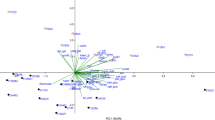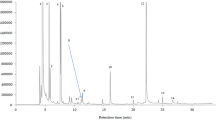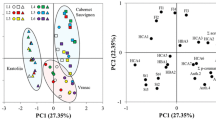Abstract
Proving of affiliation of wine sample to either organic or conventional production system and of its geographical origin although important both for consumer safety and food control authorities is still problematic. Characteristics of Slovak and some European wines obtained by spectroscopic methods including atomic absorption spectroscopy, electron paramagnetic resonance spectroscopy (EPR) and ultraviolet–visible spectroscopy in combination with high-performance liquid chromatography and isotachophoresis processed subsequently by multivariate statistics were successfully used to differentiate Slovak organic and conventional wines according to their affiliation to production system and, at the same time, to differentiate the Slovak organic and conventional wine samples from those, produced in other European countries. From totally 74 determined experimental characteristics, concentration of Fe and Cu, ferric-reducing power values, Trolox-equivalent antioxidant capacity values evaluated from ·DPPH assay by EPR (\(\tiny \small \text{TEAC}_{{^{\cdot} \text{DPPH(EPR)}}}\)), ascorbic acid equivalents (AAE), % of radicals scavenged, concentration of citric acid, catechin and epicatechin, but also color values a* and chromaticity were identified by ANOVA, Tukey’s HSD multiple comparison and stepwise discrimination tests as the most promising characteristics for white wines differentiation, whereas Fe content and AAE for the differentiation of red wines. Recognition and prediction ability tests of the Slovak white organic and conventional wines reached 100 %, whereas in case of red wines, correctness of recognition reached 90.5 % and of the prediction ability, 90 %. High correctness of differentiation of organic and conventional samples according to the origin of wine was obtained, reaching 95.8 % for white wines and 80.7 % for red wines, with two Slovak wines misclassified as wines of Czech origin.


Similar content being viewed by others
References
Rosen JD (2010) A review of the nutrition claims made by proponents of organic food. Compr Rev Food Sci Food Saf 9:270–277
Tassoni A, Tango N, Ferri M (2013) Comparison of biogenic amine and polyphenol profiles of grape berries and wines obtained following conventional, organic and biodynamic agricultural and oenological practices. Food Chem 139(1–4):405–413
Vrček IV, Bojić M, Žuntar I, Mendaš G, Medić-Šarić M (2011) Phenol content, antioxidant activity and metal composition of Croatian wines deriving from organically and conventionally grown grapes. Food Chem 124(1):354–361
Capuano E, Boerrigter-Eenling R, Veer G, Ruth SM (2013) Analytical authentication of organic products: an overview of markers. J Sci Food Agric 93(1):12–28
Willer H, Lernoud J (2013) Organic agriculture worldwide: key results from the FiBL-IFOAM survey on organic agriculture worldwide 2013. Part 2: crop data. Research Institute of Organic Agriculture (FiBL), Frick
Bunea C-I, Pop N, Babeş AC, Matea C, Dulf FV, Bunea A (2012) Carotenoids, total polyphenols and antioxidant activity of grapes (Vitis vinifera) cultivated in organic and conventional systems. Chem Cent J 6(1):66–75
Dani C, Oliboni LS, Vanderlinde R, Bonatto D, Salvador M, Henriques JAP (2007) Phenolic content and antioxidant activities of white and purple juices manufactured with organically- or conventionally-produced grapes. Food Chem Toxicol 45(12):2574–2580
Mulero J, Pardo F, Zafrilla P (2009) Effect of principal polyphenolic components in relation to antioxidant activity in conventional and organic red wines during storage. Eur Food Res Technol 229(5):807–812. doi:10.1007/s00217-009-1117-x
Mulero J, Pardo F, Zafrilla P (2010) Antioxidant activity and phenolic composition of organic and conventional grapes and wines. J Food Comp Anal 23(6):569–574. doi:10.1016/j.jfca.2010.05.001
Machado MM, dos Santos Montagner GFF, Boligon A, Athayde ML, da Rocha MIUM, Lera JPB, Belló C, da Cruz IBM (2011) Determination of polyphenol contents and antioxidant capacity of no-alcoholic red grape products (Vitis labrusca) from conventional and organic crops. Quím Nova 34(5):798–803. doi:10.1590/S0100-40422011000500013
Yıldırım HK, Akçay YD, Güvenç U, Altındişli A, Sözmen EY (2005) Antioxidant activities of organic grape, pomace, juice, must, wine and their correlation with phenolic content. Int J Food Sci Technol 40(2):133–142. doi:10.1111/j.1365-2621.2004.00921.x
Otreba JB, Berghofer E, Wendelin S, Eder R (2006) Polyphenols anti-oxidative capacity in Austrian wines from conventional a organic grape production. Mitteilungen Klosterneuburg, Rebe und Wein, Obstbau und Fruchteverwertung 56(1–2):22–32
Micelli A, Negro C, Tommasi L, De Leo P (2003) Polyphenols, resveratrol, antioxidant activity a ochratoxin and contamination in red table wines, controlled denomination of origin (DOC) wines and wines obtained from organic farming. J Wine Res 14(2–3):115–120
Yildirim HK, Akçay YD, Güvenç U, Altindişli A, Sözmen EY (2004) Protection capacity against low-density lipoprotein oxidation a antioxidant potential of some organic a non-organic wines. Int J Food Sci Nutr 55:351–362
Núñez-Delicado E, Sánchez-Ferrer A, García-Carmona FF, López- Nicolás JM (2005) Organic grapes contain higher levels of latent polyphenol oxidase then conventionally grown Wine Grapes. J Food Sci 70(1):C74–C78
Yildirim HK, Üren A, Yücel U (2007) Evaluation of biogenic amines in organic and non-organic wines by HPLC OPA derivatization. Food Technol Biotech 45(1):62–68
Malusa E, Laurenti E, Ghibaudi E, Rolle L (2004) Influence of organic a conventional management on yield a composition of grape cv ‘Grignolino. Acta Hortic (640):135–141
Lante A, Crapisi A, Lomolino G, Spettoli P (2004) Chemical parameters, biologically active polyphenols a sensory characteristics of some Italian organic wines. J Wine Res (15):203–209
Yıldırım HK, Akcay YD, Guvenc U, Sozmen EY (2004) Protection capacity against low-density lipoprotein oxidation a antioxidant potential of some organic a non-organic wines. Int J Food Sci Nutr 55:351–362
Vian MA, Tomao V, Coulomb PO, Lacombe JM, Dangles O (2006) Comparison of the anthocyanin composition during ripening of Syrah grapes grown using organic or conventional agricultural practices. J Agri Food Chem 54:5230–5235
Pohl P (2007) What do metals tell us about wine? Trends Anal Chem 26:843–950
Saurina J (2010) Characterization of wines using compositional profiles and chemometrics. Trends Anal Chem 29:234–245
Cozzolino D, Holdstock M, Dambergs RG, Cynkar WU, Smith PA (2009) Mid infrared spectroscopy and multivariate analysis: a tool to discriminate between organic and non-organic wines grown in Australia. Food Chem 116(3):761–765
Commission E (2007) Council Regulation (EC) No. 834/2007 of 28 June 2007 on organic production and labelling of organic products and repealing Regulation (EEC) No. 2092/91, vol 834/2007. Luxembourg
Ministry of Agriculture of the Slovak Republic (2009) Slovak Regulation No. 189/2009 on organic agricultural production, vol 189/2009. Bratislava, Slovak Republic
Čurlík J, Šefčík P (1999) Geochemical atlas of the Slovak Republic, Part V: soils. Ministry of the Environment of the Slovak Republic, Bratislava, Slovak Republic
Re R, Pellegrini N, Proteggente A, Pannala A, Yang M, Rice-Evans C (1999) Antioxidant activity applying an improved ABTS radical cation decolorization assay. Free Radic Biol Med 26(9–10):1231–1237
Chyau C-C, Tsai S-Y, Ko P-T, Mau J-L (2002) Antioxidant properties of solvent extracts from Terminalia catappa leaves. Food Chem 78(4):483–488. doi:10.1016/S0308-8146(02)00162-0
Staško A, Brezová V, Liptáková M, Šavel J (2000) Thermally initiated radical reactions of K2S2O8: EPR spin trapping investigations. Magn Reson Chem 38(11):957–962. doi:10.1002/1097-458X(200011)38:11<957
Staško A, Polovka M, Brezová V, Biskupič S, Malı́k F (2006) Tokay wines as scavengers of free radicals (an EPR study). Food Chem 96(2):185–196. doi:10.1016/j.foodchem.2005.02.022
Polovka M, Suhaj M (2010) Detection of caraway and bay leaves irradiation based on their extracts’ antioxidant properties evaluation. Food Chem 119(1):391–401. doi:10.1016/j.foodchem.2009.07.005
Polovka M, Šťavíková L, Hohnová B, Karásek P, Roth M (2010) Offline combination of pressurized fluid extraction and electron paramagnetic resonance spectroscopy for antioxidant activity of grape skin extracts assessment. J Chromatogr A 1217(51):7990–8000. doi:10.1016/j.chroma.2010.08.003
Tobolková B, Durec J, Belajová E, Mihalíková M, Polovka M, Suhaj M, Daško Ľ, Šimko P (2013) Effect of light conditions on physico-chemical properties of pineapple juice with addition of small pineapple pieces during storage. J Food Nutr Res 52(3):181–190
Sádecká J, Májek P, Tóthová J (2008) CE profiling of organic acids in distilled alcohol beverages using pattern recognition analysis. Chromatographia 67(Suppl. 1):S69–S74
Berrueta LA, Alfonso-Salces RM, Héberger K (2007) Supervised pattern recognition in food analysis. J Chromatogr A 1158(1–2):196–214
Acknowledgments
This publication is the result of the project “Centre of Excellence for Contaminants and Microorganisms in Food—ITMS 26240120024” implementation, supported by the Research and Development Operational Programme funded by the ERDF. Wine producers Vino Natural Domin and Kušický and Agro Movino Veľký Krtíš are gratefully acknowledged for their kind cooperation and samples provision.
Conflict of interest
None.
Compliance with Ethics Requirements
This article does not contain any studies with human or animal subjects.
Author information
Authors and Affiliations
Corresponding author
Rights and permissions
About this article
Cite this article
Tobolková, B., Polovka, M., Belajová, E. et al. Possibilities of organic and conventional wines differentiation on the basis of multivariate analysis of their characteristics (EPR, UV–Vis, HPLC and AAS study). Eur Food Res Technol 239, 441–451 (2014). https://doi.org/10.1007/s00217-014-2237-5
Received:
Revised:
Accepted:
Published:
Issue Date:
DOI: https://doi.org/10.1007/s00217-014-2237-5




